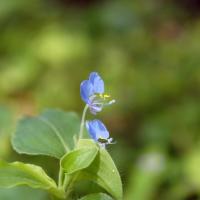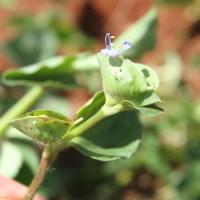Benghal dayflower
Commelina benghalensis
Benghal dayflower, scientifically known as Commelina benghalensis, is a herbaceous annual plant in the Commelinaceae family. It is native to tropical and subtropical regions of Asia and Africa. This plant is known for its distinctive blue flowers and is considered both a weed and an ornamental plant in different contexts. Here is a description of Benghal dayflower:
Appearance:
- Benghal dayflower is a low-growing annual herb that typically reaches heights of about 6 to 20 inches (15 to 50 cm).
- The leaves are lance-shaped and alternately arranged along the stems. They can vary in size and have a smooth or slightly hairy surface.
- The most distinctive feature of Benghal dayflower is its flowers. The flowers are bright blue to violet-blue, with three petals that are uneven in size and shape. Two of the petals are smaller and are bright blue, while the third petal is larger and is paler in color.
- Flowers are typically borne on long, slender stems and are ephemeral, lasting only for a short period each day.
Habitat:
- Benghal dayflower is adaptable to a wide range of habitats but is often found in disturbed areas, gardens, agricultural fields, and along roadsides.
- It thrives in moist to wet conditions and can tolerate periods of drought.
Lifecycle:
- Benghal dayflower is an annual plant, completing its life cycle within a single growing season.
- It reproduces primarily by seeds, which are dispersed by wind, water, or through human activities.
Impact:
- While Benghal dayflower has attractive blue flowers and is sometimes cultivated as an ornamental plant, it is also considered a weed in agricultural settings. It can compete with cultivated crops for resources and may reduce crop yields.
- In some regions, it is also considered a noxious weed due to its ability to establish dense populations.
Control:
- Control measures for Benghal dayflower may include manual removal of plants, cultivation practices, and the use of herbicides in agricultural settings.
- Effective weed management strategies aim to prevent seed production and reduce the weed's presence in fields and gardens.




















Prodotti fitosanitari
- N/A
- N/A
- N/A
- N/A
- N/A
- N/A
- N/A
- N/A
- N/A
- N/A
- N/A
- N/A
- N/A
- N/A
- N/A
- N/A
- N/A
- N/A
- N/A
- N/A
- N/A
- N/A
- N/A
- N/A
- N/A
- N/A
- N/A
- N/A
- N/A
- N/A
- N/A
- N/A
- N/A
- N/A
- N/A
- N/A
- N/A
- N/A
- N/A
- N/A
- N/A
- N/A
- N/A
- N/A
- N/A
- N/A
- N/A
- N/A
- N/A
- N/A
- N/A
- N/A
- N/A
- N/A
- N/A
- N/A
- N/A
- N/A
- N/A
- N/A
- N/A
- N/A
- N/A
- N/A
- N/A
- N/A
- N/A
- N/A
- N/A
- N/A